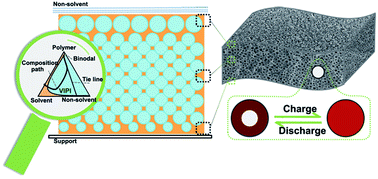Vapour induced phase inversion: preparing high performance self-standing sponge-like electrodes with a sulfur loading of over 10 mg cm−2†
Abstract
To obtain a satisfactory rate performance of lithium–sulfur (Li–S) batteries with a high sulfur loading, the vapour induced phase inversion (VIPI) process was used to prepare sponge-like porous electrodes. It is suitable for various solvents, binders and materials on account of phase separation principles and produces electrodes with enhanced adhesive properties, high electrolyte uptake and improved capability in electron/ion transport. As a result, batteries assembled with the VIPIE delivered a high initial discharge capacity of 1171 mA h g−1 and presented a capacity retention of 56.6% within 400 cycles at 0.5C. Additionally, a high discharge capacity of 693 mA h g−1 could be also obtained at 2C due to the facilitated electron/ion transport. An electrode with a high sulfur loading of 19 mg cm−2 could be realized. The 10 mg cm−2 sulfur loaded VIPIE delivered a high capacity of 1300 mA h g−1 at 0.05C (equaling to an areal capacity of 13.0 mA h cm−2) and showed a high capacity retention of 90.7% within 60 cycles at 0.1C.



 Please wait while we load your content...
Please wait while we load your content...